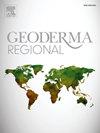调查影响斐济群岛半城市-农村家庭园艺界面痕量元素污染的土壤理化因素
IF 3.3
2区 农林科学
Q2 SOIL SCIENCE
引用次数: 0
摘要
由于其对生态和公共健康的影响,家庭园艺土壤污染具有挑战性。然而,斐济半城市-农村家庭园艺土壤界面中微量元素污染的物理化学因素尚不清楚。研究人员利用自组织图(SOM)、化学计量学、成分数据分析(CDA)和土壤质量指数评估了斐济半城市和农村地区 55 个土壤样本中微量元素污染的空间模式、污染特征、来源和影响因素。二乙烯三胺五乙酸(DTPA)可萃取形式的微量元素平均含量(毫克/千克)在农村地区增加为铁(55.7)> 锰(40.4)> 锌(9.4)> 铜(5.9),在半城市地区增加为铁(55.2)> 锌(35.9)> 锰(37.1)> 铜(16.1)。与半城市化土壤相比,农村土壤对家庭园艺的生态风险较小。SOM 和 CDA 分析显示出四个空间群:群 1 和群 3 是农村地区的自然地质源,群 2 和群 4 是半城市地区的人为非点源。主成分分析(PCA)和分层聚类分析显示,半城市地区的铜-锌更多地受到制造业排放或施肥的影响,而农村地区的铁-锰则更多地受到石成源的影响。研究发现,pH 值和有机质对半城市土壤中的铜和锌污染有显著影响(p < 0.05)。对于农村和半城市土壤,使用逐步回归模型,微量元素子集可解释 44 %-87 % 的土壤污染变化。这些研究结果有助于建立生态环境风险初级数据库,促进评估土壤污染和食品安全潜在威胁的综合战略。本文章由计算机程序翻译,如有差异,请以英文原文为准。
Investigating soil physicochemical factors influencing trace element contamination at the semi-urban-rural home gardening interfaces on the Fiji Islands
Due to its ecological and public health implications, home gardening soil pollution is challenging. However, the physicochemical factors of trace element pollution in semi-urban-rural home gardening soil interfaces in Fiji are unclear. Self-organizing map (SOM), chemometrics, compositional data analysis (CDA), and soil quality indices were used to evaluate spatial patterns, contamination characteristics, sources, and factors affecting trace element contamination in 55 soil samples from semi-urban and rural Fiji. The average contents of diethylenetriaminepentaacetic acid (DTPA)-extractable forms of trace element levels (mg/kg) increased in rural areas as Fe (55.7) > Mn (40.4) > Zn (9.4) > Cu (5.9) and semi-urban areas as Fe (55.2) > Zn (35.9) > Mn (37.1) > Cu (16.1). Rural soils have less ecological risks to home gardening than semi-urban soils. SOM and CDA analysis showed four spatial clusters: clusters 1 and 3 are natural geogenic in rural regions while clusters 2 and 4 are human-induced non-point sources in semi-urban areas. Principal component analysis (PCA) and hierarchical cluster analysis showed that semi-urban Cu-Zn was more affected by manufacturing emissions or fertilization, whereas rural Fe-Mn was more likely to be lithogenic. The research found that pH and organic matter significantly affect Cu and Zn pollution in semi-urban soils (p < 0.05). For rural and semi-urban soils, trace element subsets explained 44 %–87 % of soil contamination changes using the stepwise regression model. These findings aid to establishing a primary database of eco-environmental risks and facilitate comprehensive strategies for assessing soil contamination and potential threats to food safety.
求助全文
通过发布文献求助,成功后即可免费获取论文全文。
去求助
来源期刊

Geoderma Regional
Agricultural and Biological Sciences-Soil Science
CiteScore
6.10
自引率
7.30%
发文量
122
审稿时长
76 days
期刊介绍:
Global issues require studies and solutions on national and regional levels. Geoderma Regional focuses on studies that increase understanding and advance our scientific knowledge of soils in all regions of the world. The journal embraces every aspect of soil science and welcomes reviews of regional progress.
 求助内容:
求助内容: 应助结果提醒方式:
应助结果提醒方式:


